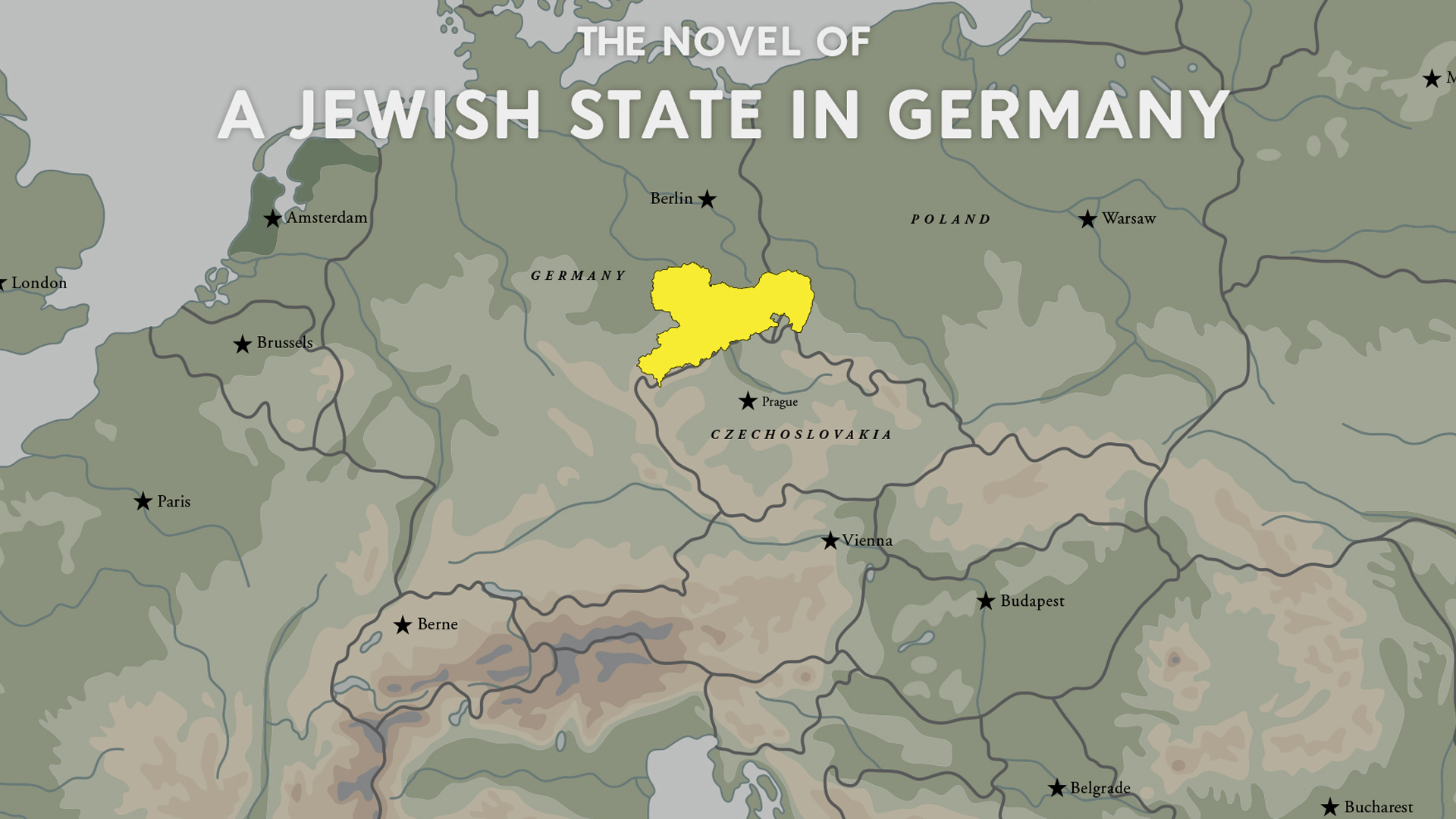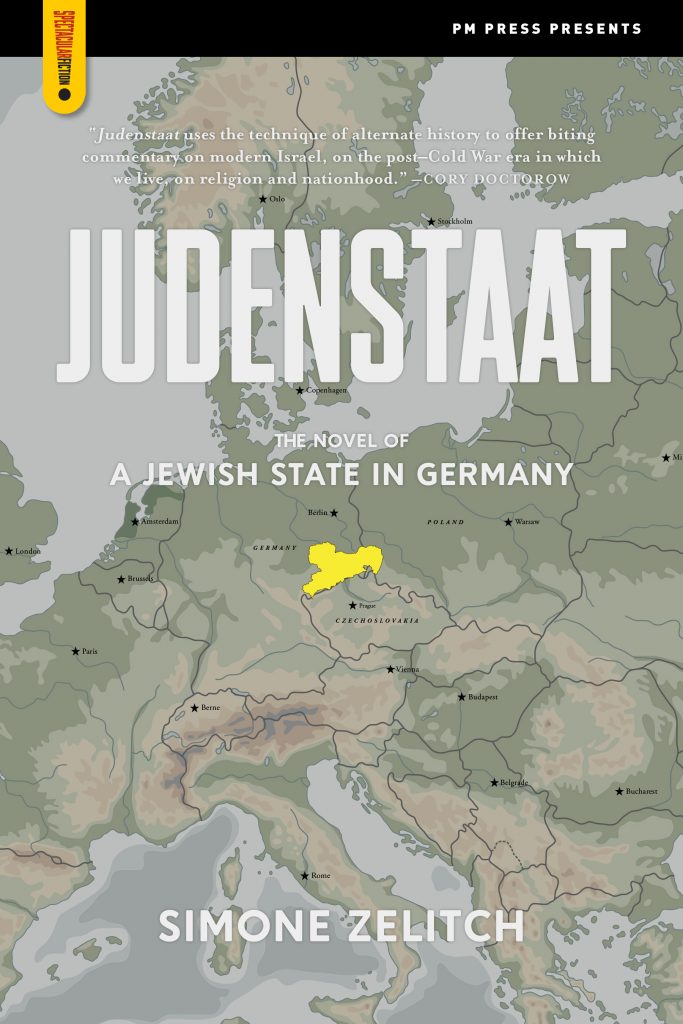In Simone Zelitch’s imaginary Judenstaat, the flag resembles Auschwitz uniforms, German beats Yiddish, and the Soviets – unsurprisingly – are the bad guys.
By Yaad Biran
Haaretz
April 6th, 2017

What would have happened if the Jewish state had been established in eastern Germany after World War II? What would have happened if the State of Israel had been crossbred with East Germany? This is the premise of “Judenstaat,” a work of alternative history, which as a literary genre maintains a complex relationship with reality and is prone to failure.
The flag of the country of Judenstaat has blue-and-white stripes like the prison uniforms at Auschwitz with a yellow patch at its center. Author Simone Zelitch envisions a state that adopts the hatred toward it and translates it into a contrarian but positive identity. This state of the Jews, established mainly because of anti-Semitism and persecution in Europe, is established on that continent, and the colonialist issues that the real-life State of Israel must cope with are thus eliminated. But that doesn’t mean that all the problems have been resolved.
Judenstaat still faces hostile minorities. The “Saxon question” preoccupies the country’s leaders. A huge wall separates Judenstaat from “fascist” Germany, and great educational and cultural efforts are made to prove that Saxony is the cradle of German-Jewish culture. However, the leaders claim that the concept of a separate Saxon identity is nothing more than a myth or a plot to sabotage the Jews’ historical right to their country.
Zelitch hints at archaeological excavations at Saxon sites whose findings are used to establish a national identity. But this issue isn’t developed and the satirical dimension relating to actual Israeli archaeology is only hinted at.

Judit, the book’s protagonist, works as a film editor at Judenstaat’s national museum, and perhaps too symbolically is asked to re-edit the state’s official historical narrative as presented in old movies. She herself believes in facts and historical justice, and slowly stops believing in Judenstaat’s pervasive propaganda. She also falls in love with Hans, a romantic Saxon musician. Indeed, their Christian-Jewish love story, which ends with Hans’ murder, is the takeoff point for the plot, which deals with the search for the murderer.
Many central themes are not sufficiently developed here, even though they raise intriguing questions. One of the founders of Judenstaat and its first prime minister is Stein, a German Jew who believes that all European Jews are Germans. Yiddish, after all, is a German dialect and in every Diaspora (i.e., Eastern European) Jew there hides a German-Jewish spark.
The idea that Yiddish attests to the German origin of all European Jews is not Zelitch’s invention; it was a school of thought among 19th-century intellectuals, who sought to refashion Judaism as a religion consistent with enlightened European principles. Zelitch thus uses an existing idea, but turns it into one of the foundations of Jewish-German national identity, which in the story in question includes a state and an army.

Distorted mirror
The reflection of Zionist ideas in this distorted mirror is fascinating, but unfortunately we don’t learn more about how such ideas developed in Judenstaat, what the country’s authors or poets write about it, or how generations of education ministers integrated them into the school curricula. Obviously, a 300-page novel doesn’t have the space for all these details, but it seems as if Zelitch is presenting this worldview as self-evident, and rushes on to the conflict that is the focal point of her book.
The portrayal of Judenstaat’s ultra-Orthodox, or Haredi, community is weak and filtered through the sieve of the book’s secular protagonist. It’s therefore saturated with hatred that doesn’t permit an in-depth look. The only Haredim who receive some attention are the German-speaking Chabad Hasids, who seek the company of secular Jews so they can turn them into observant ones.
Another idea underlying Zelitch’s Judenstaat involved mobilization of the Bund (the secular Jewish socialist movement founded in Russia in the late 19th century) – or at least its postwar remnants – in establishment of the German-Jewish state. Zelitch assumes in her book that the Bund cooperates with the Soviet regime and helps to integrate Judenstaat into the East Bloc. But could the anti-Bolshevik Bund really have experienced such a revolution in its political and ideological path? It’s hard to say. Still, it seems that Zelitch isn’t very sensitive to the actual, historic Bund and flattens it into a one-dimensional entity.
As a result, one wonders about the victory of German over Yiddish as Judenstaat’s official language. These languages seem to embody the two central forces operating in the state’s cultural arena – the Jews of the German Enlightenment and the ethnic, Yiddish-speaking Jews of Eastern Europe. But Yiddish in Judenstaat has been sidelined as the language of the black-hatted religious folks. To be modern in Judenstaat is to speak German, just as in the young State of Israel a connection was forged between modern existence and the Hebrew language.
But what happened to the Yiddish modernity of the Bund and other Yiddishists? How was Yiddish actually defeated? In “Judenstaat,” Zelitch attributes its loss to German to a secret order by Joseph Stalin. Having suffered enough from the trouble-making, Yiddish-speaking Jews in the Soviet Union, during the early 1950s, he forces Judenstaat’s leaders to make German their country’s official language.
We also read that in 1935, Stein, one of the state’s visionaries, saw Yiddish as too international and anarchist to be a national language per se. He also seeks to reorganize the Bund movement to suit the mold of a typical national movement.
Is Zelitch hinting here that the German identity of the Jewish state is a Stalinist project and that denying Yiddish is one of its main sins? I would have liked to have read something to this effect in her book, but alas it is not discussed.
Cold War role
Most of Zelitch’s attention is devoted to the role Judenstaat plays in the Cold War. The little country oscillates between communism and liberalism, and between nationally oriented and cosmopolitan ideas. It is a country of the Stasi, which is afraid to reject Soviet domination. The good intentions inherent in the Enlightenment, in territorial ideas regarding the right of the Jews to a safe haven, and in the socialist humanism of the Bund are swallowed up by a totalitarian nationalist police state that serves imperial objectives. The rescue and memory project becomes a Soviet manipulation.
In some respects, the portrait Zelitch paints is reminiscent of the Jewish state in Alaska that Michael Chabon created in his book “The Yiddish Policeman’s Union,” which also reflects the problems of the real State of Israel and hints that any Jewish state would suffer from the same issues.
The collage-like character of Judenstaat is a good thing, especially when it is compared to other novels of this genre. It’s impossible to fully present the complex history of an imaginary country, and thus we receive glimpses of various historical phenomena that provide an opening to a multitude of voices and leave much to the imagination. This structure rescues the book from falling into clichés, but is also its weak point.
Zelitch chose the late 1980s as the period in which the plot of her book takes place, and as a result most of the attention is directed at refuting the Soviet narrative that dominates Judenstaat’s consciousness. But it’s too easy to describe this era, the eve of the fall of the Eastern Bloc. Everything is tinged with the joy of the Fukiyama-style “end of history,” so the secret that’s revealed – the crimes of the Soviets – does not surprise us enough.
It seems as if Zelitch is viewing her heroine from above, from North America and a distance of 30 years. This leaves us with too many issues that are only partially developed, if at all. I, for example, would love to know what’s happening in Judenstaat in 2017.







